Jump to:
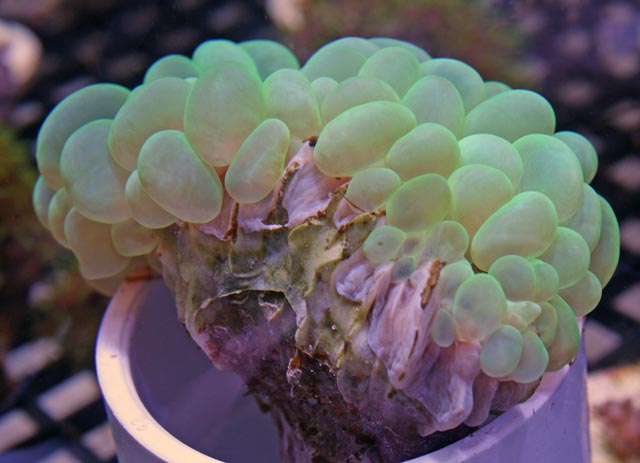
Introduction

The Euphyllidae family of corals are in the order Scleractinia (stony corals) and the subclass Hexacorallia (or also known as Zoantharia). Being in the Hexacorallia subclass means that the polyps have tentacles in multiples of six. Euphyllid corals were formerly classified with Caryophllidae, but research into their phylogeny demanded a new taxonomic family of classification. Some common genera of Euphyllidae are: Catalaphyllia, Ephyllia, Nemenzophyllia, Physogyra, and Plerogyra. For more detailed descriptions of each genus, please scroll to the bottom of the page.

Euphyllid corals are found in the Indo-West Pacific Oceans and are heterotrophic. They gain their energy from their zooxanthellae (dinoflagellate algae) and from capturing prey such as zooplankton</a >. They cannot survive on photosynthesis alone. Most agree that brine shrimp and pureed meaty aquarium supplements are ideal for weekly feedings. Some clownfish may adopt Euphyllids as a surrogate anemone. Some report that this is especially frequent with Catalaphyllia spp. and Salty Underground has witnessed it in customers' reef aquariums with various species of Euphyllia and Plerogyra (the anchor and bubble corals). Unfortunately for the coral, the polyps may feel irritated, never fully extend, or may ultimately die.
Many species in this family are considered vulnerable or threatened due to over-collection for the aquarium trade or general reef destruction. It is recommended to contact your retailer/wholesaler to determine if the specimen is aquacultured, maricultured, or collected.
Genera
Catalaphyllia
Check our current stock</a >Common Species: C. jardinei
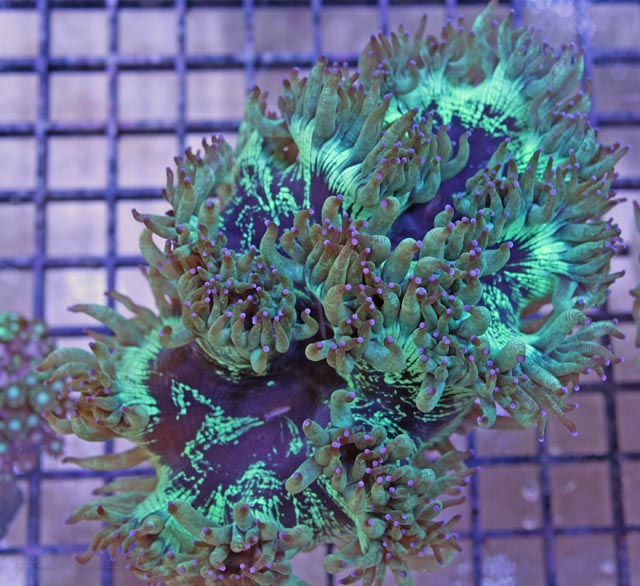
Common names for C. jardinei are wonder coral, elegant coral, and elegance coral. These beautiful corals have large, fleshy, oral discs, and long tentacles. The polyps come from unfused corallites in meandering valleys (referred to as flabello-meandroid). The oral disc is often striped, and the polyp can be brown, cream, green, or blue, and the tentacles and tentacle tips often have contrasting colors, such as pink or purple, as well. When extended, the tentacles lend an “anemone-like” appearance to the coral-but Catalaphyllia has a huge, fleshy, oral disc. At night, the polyps and tentacles retract somewhat, giving an appearance of an oral disc fringed by beads.
Additionally, elegance corals are not attached to the substrate. Their base is cone-shaped, and buried in the substrate. In nature, they can be found in muddy or sandy bottoms of lagoons. They prefer turbid waters, with low to moderate current. Due to their delicate nature, do not place them on a hard substrate in your reef aquarium. If placed on live rock, instead of sand, the polyp will become abraded when it extends and retracts. This may lead to infection. In addition, wonder corals will sting-you and nearby corals-and they grow quickly. That being said, Catalaphyllia corals not only need a soft substrate but also room to expand.
Euphyllia
Check our current stock</a >Common Species: E. ancora, E. divisa, E. fibriata, E. glabrescens, E. cristata, E. paradivisa, E. paraancora, E. yaeyamaensis</em >
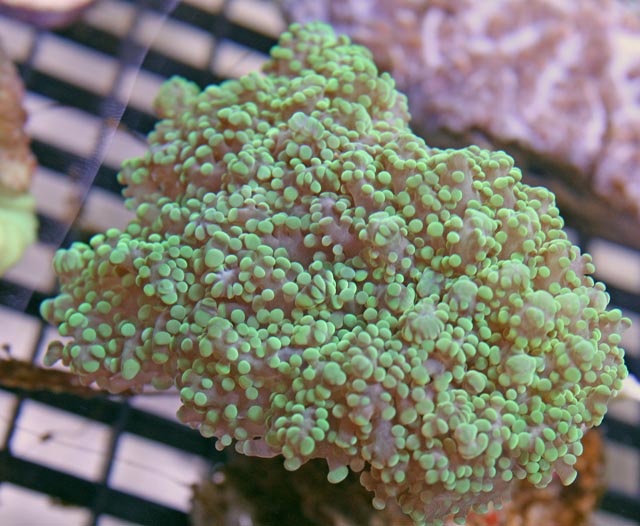
Common names for Euphyllia spp. are hammer coral, anchor coral, grape coral, frogspawn coral, torch coral, pom-pom coral, octopus coral, branching hammer coral, branching frogspawn coral, and branching anchor coral. It is rather easy to tell the Euphyllia spp. apart. E. ancora is the hammer or anchor coral and E. divisa is the frogspawn or octopus coral. Both of these species have phacelo-meandroid skeletons. E. glabrescens is torch coral, E. cristata is grape coral, E. paradivisa and E. fibriata is branching frogspawn or branching octopus, and E. paraancora is branching hammer or branching anchor. Those species all have phaceloid (the tall corallites arise separately from the skeleton), branching skeletons. Looking down at the colony, this is evident by a “crowded” appearance for the phaceloid forms, and “rosette” forms for the branching skeletons. As colonies of Euphyllia spp. are phaceloid, and some are branching, they may be fragmented for propagation purposes. These corals will also reproduce via asexual budding.
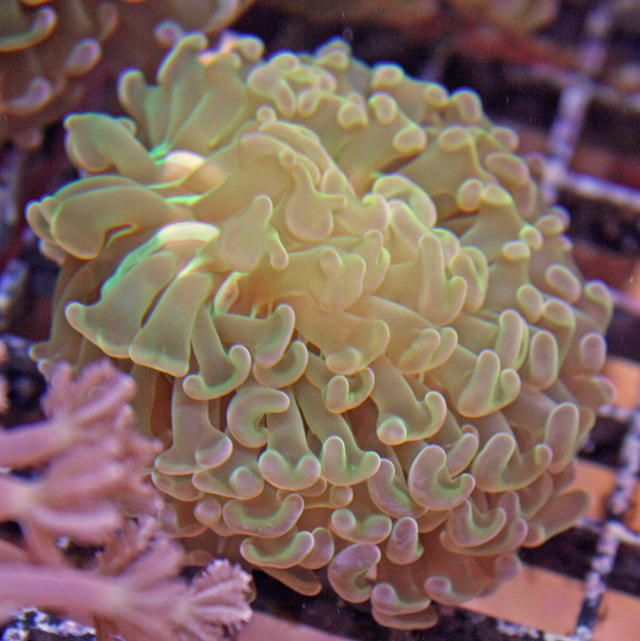
Euphyllia corals come in a variety of beautiful colors, like various shades of green, brown, pink, blue, and red. The tentacles at time can be clear, and the tentacle tips, or zooxanthellae sacs, are normally of a brighter, contrasting hue. They prefer moderate current and moderate lighting intensity, and prefer to feed at night. They will develop sweeper tentacles capable of quite a sting, so be sure to place them well away from other types of coral. These corals prefer meaty foods, such as krill, and there are a variety of meat supplements available to aquarists. You should be careful if planning to include Euphyllia corals in the same aquarium with soft corals.
Nemenzophyllia
Check our current stock</a >Single Species: N. turbida
Common names for Nemenzophyllia spp. are fox coral, jasmine coral, and ridge coral. Jasmine corals are found in shallow reef zones, which are sheltered or turbid-like on a back reef slope. Although it is considered vulnerable and rare, when N. turbida is found, it can form large carpets of mono-specific zones. They may be green, cream, or brown, and have a delicately ruffled oral disc. It does best with moderate lighting and low to moderate water current. Unlike other Euphyllids, Nemenzophyllia corals gain energy through direct uptake of nutrients from the water. With that being the case, it is recommended against having a strong skimmer or efficient mechanical filtration, as this will effectively starve the coral. Fox corals are considered to be aggressive.
Physogyra
Check our current stock</a >Common Species: P. lichtensteini
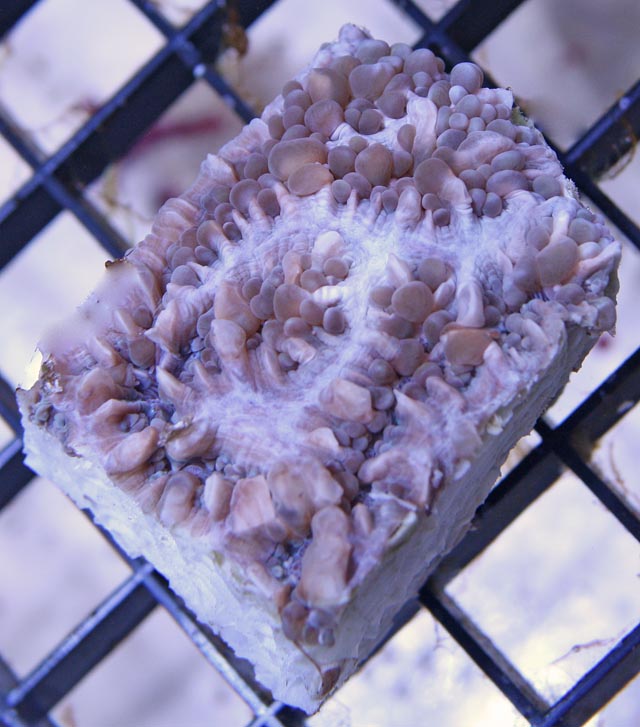
Common names for Physogyra spp. are pearl coral, grape coral, and small bubble coral. This small bubble coral is not only found throughout Indonesia, Malaysia, and Australia, but also can be found as far west as Madagascar, and even in the Red Sea. These are common, but vulnerable, according to the IUCN Red List of Endangered Species</a >. Physogyra corals are normally found in shallow reef zones, with protected, turbid waters, but also will be spotted in other reef zones. They will also tolerate a higher intensity of light than its counterparts, but not too strong. Physogryra spp. can be cream, ivory, green, and brown. You will also commonly see contrasting colors when the polyp is retracted. Unlike Plerogyra spp., Physogrya spp. corallites have fused walls in its meandroid structure. The small bubble coral is better able to retract its bubble polyps as well.
Plerogyra
Check our current stock</a >Common Species: P. cauliformis, P. diabolotus, P. discus, P. multiobata, P. simplex, P. sinuosa</em >
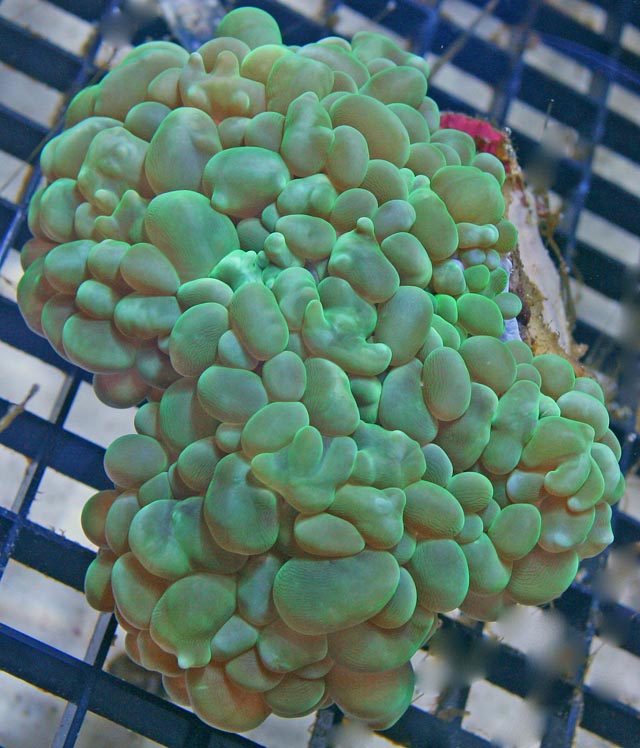
Common names for Plerogyra spp. are bubble coral, bladder coral, grape coral, pearl coral, and octobubble coral. It is widespread in the Indian and Pacific Oceans, as well as the Red Sea. Bubble corals are usually found in protected reef zones under low light intensity, such as in a sea cave or below other corals and overhangs. Bladder corals have corallites that grow in a meadroid manner, but their walls remain unfused. This is referred to as “flabello-meadroid”. Their “bubbles”, or tentacle tips, are sacs of zooxanthellae that will only fully “inflate” in low light. Therefore, for the prettiest specimens, choose to place Plerogyra spp. in shady areas of your aquarium or under low light. The octobubble corals have the same zooxanthellae sacs accompanied by an additional extension at the tip of the bubble. When fully extended, or inflated, the bubbles take on a striated appearance due to translucent streaks in the pigmentation of the bubbles. They are most popular in a bright green, but are also found in ivory and cream colorations. Beware of sweeper tentacles, which seem to form mostly at night or under strong current. They will sting you! If you accidentally tear or puncture a bubble, Plerogyra spp. become more susceptible to brown jelly infection. These reproduce asexually via budding daughter colonies.
References
Borneman, E. (2001). Aquarium Corals: selection, husbandry, and natural history. Neptune City, NJ: T.F.H Publications.
Calfo, A.R. (2002). Book of Coral Propagation: A concise guide to the successful care and culture of coral reef invertebrates (Vol. 1).</em > Monroeville, PA: Reading Trees.
Reef Corals of the Indo-Malaysian Seas. (2011). Marine Species Identification Portal. Retrieved on July 24th, 2011, from http://species-identification.org</a >
Veron, J.E.N. (2000). Corals of the world. Volumes 1-3. Townsville, Queensland, Australia., Australian Institute of Marine Science.
